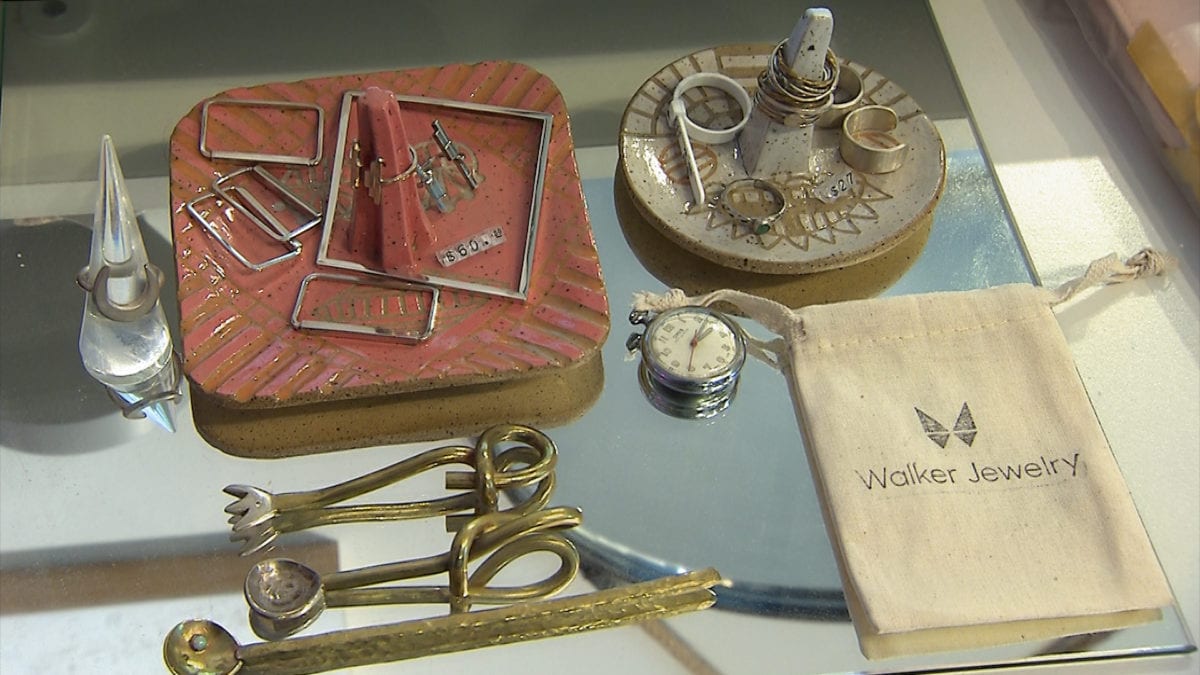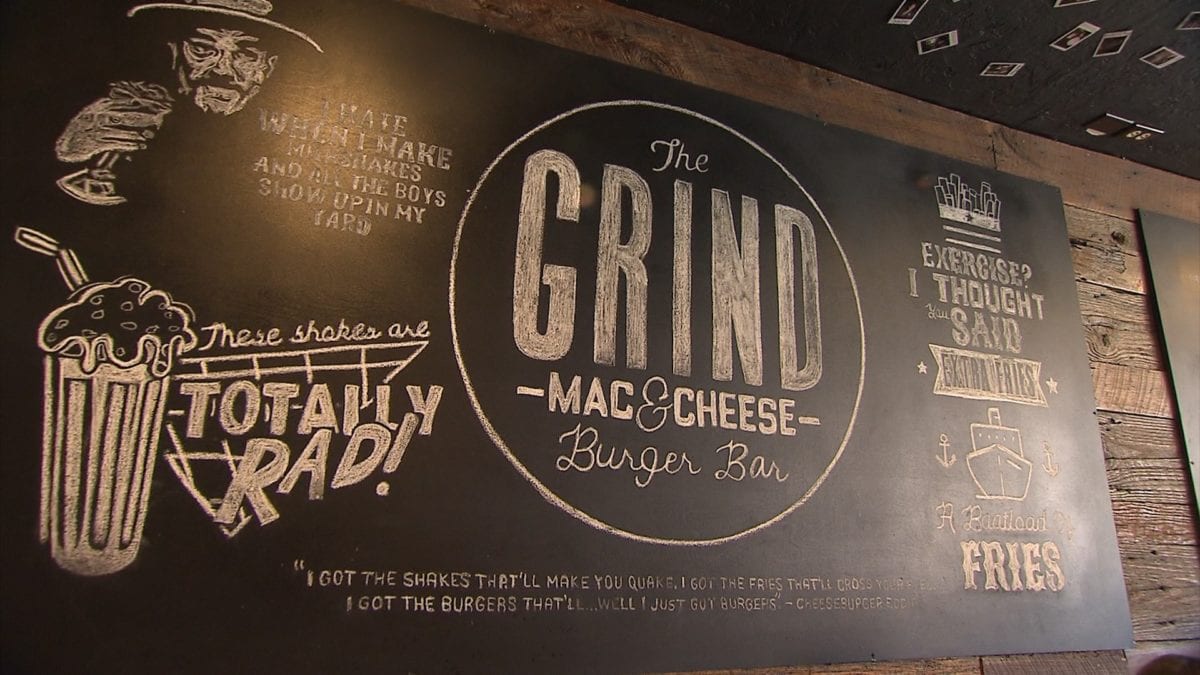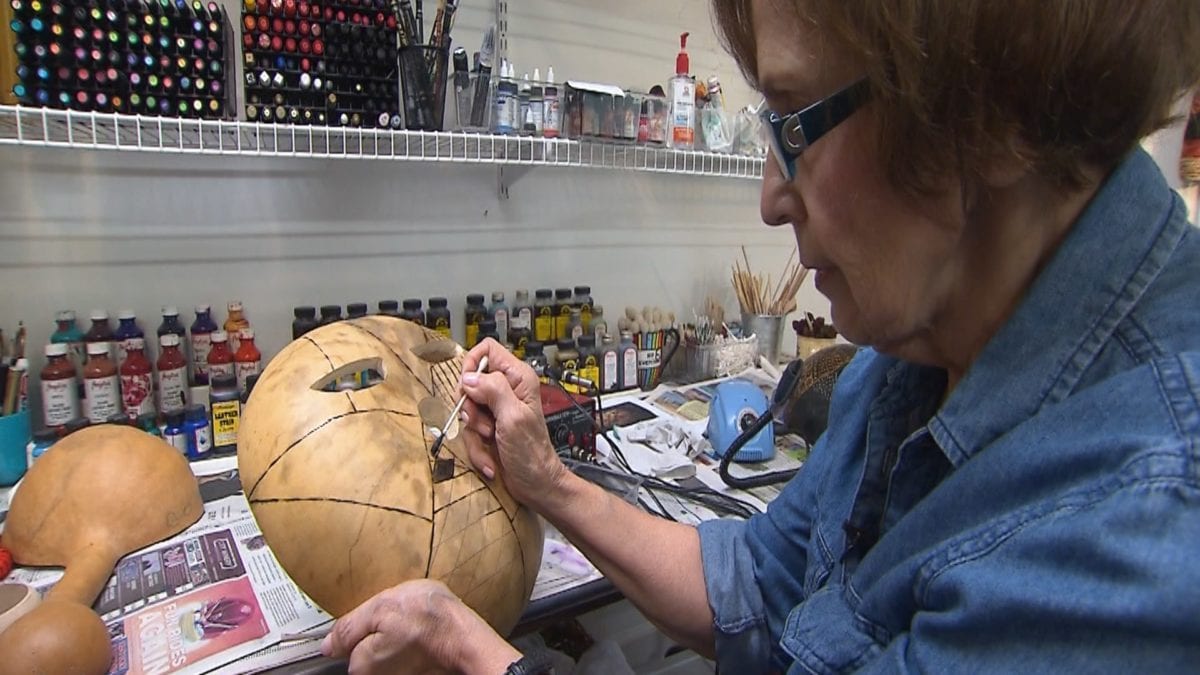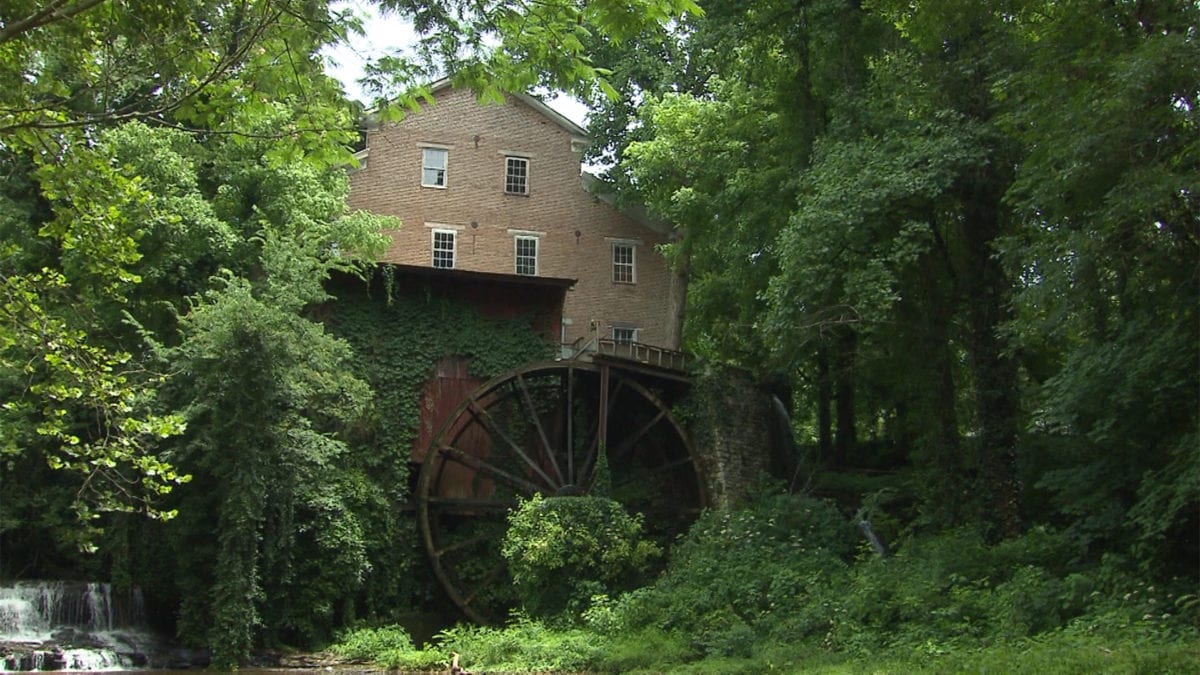Episode 3504
Don't have the PBS App? Click Here
Episode Transcript
- [Announcer] Published by Tennessee State Parks, The Tennessee Conservationist magazine features articles on native species, culture, and history, connecting readers with Tennessee's natural resources, and recreational activities. More information at tnconservationist.org. - This time on Tennessee Crossroads, we meet an Old Hickory artist who can bring new life to your ancient heirlooms. Then travel to Martin for a down-home high energy dining experience. We'll visit Historic Falls Mill in Belvedere, and meet a woman who found an artistic use for gourds, that's right, gourds. This is Tennessee Crossroads, I'm Joe Elmore, welcome. Whether it's a ring, a necklace, a broach, or a bracelet, most of us have some old jewelry tucked away that we're not quite sure what to do with. What if your old heirlooms could be given new life? Well, in our first story, Miranda Cohen introduces us to a unique artist in Old Hickory, one who can help you forge old memories into new ones. - [Miranda] Smoke, fire, hammers, and sand. It looks like Lindsay Walker is making something industrial. Actually this Charleston, South Carolina native is making elegant, one of a kind pieces of jewelry, and no one is more surprised than she is. - Metal just always kind of had a fascination to me. I was always drawn by it, and the first time I soldered, I knew, just seeing the way that the metal changed as you heated it, I was mesmerized, absolutely fell in love with metalwork at that point, and knew I wanted to pursue it, just didn't realize that it would fall into the category of jewelry. - [Miranda] Long before she opened her own shop, Walker Jewelry, tucked away in The Artists' Cove of Old Hickory, Tennessee, she traveled the world, taking in the culture, and attending prestigious schools abroad. - I'd moved to Denmark, and lived there for six years, and got into a jewelry design program that lasted three years, and then was able to study sustainability and design. - [Miranda] Having learned how to manipulate, and craft metals and rare gems, she then turned her attentions to her own family memories. - [Lindsay] I always, you know, would play with my mom's jewelry, or look at it, and admire it, and you know, it's another part of stories being carried on to the next generation. - [Miranda] And Walker discovered the family stories and cherished memories were even more precious than the stones and metals themselves. - I had a customer come and bring me lots of her family's gold, and beautiful diamonds, but I was able to take all of their gold, and make both their wedding bands, and engagement rings from the family's jewelry, so that's really special, hearing things like that, of the legacy of people. So this is Dutch sand. It's got a little bit of silicone in it. - [Miranda] Walker is trained in an ancient technique called sand casting. It is time-consuming and meticulous, but the results are stunning. - And this was a technique used in the Bronze Age. I do all my own casting, so I'll actually take their gold or silver, and melt it down, and reform it into something new, carrying on that background story, and importance of the sentimental, you know, because jewelry has value in its properties, but it also has value in the memories that it carries. - One of Lindsey Walker's favorite things to do is to work with clients individually, to make very special pieces. In this case, she's working with a groom to make a very special wedding band. For the metal, she is using shells from his grandfather's 21 gun salute. - A little bit tricky, since it's very thin brass, but I was able to cut it open, and saw out small circles, and then kind of inlay that into his ring, so that's special. - [Miranda] Walker collaborates with couples to create their own unique heirloom jewelry, capturing the essence of their personalities and style. - [Lindsay] I work with couples I feel a lot of times that have a different perspective of getting married, or finding the right engagement ring, or wedding set. - [Miranda] Walker also teaches classes in how to make your own jewelry from gems and precious metals. - [Lindsay] Anyone can come in despite, you know, their background, and learn all the techniques that I use every day, all the traditional silversmith, goldsmith techniques. - [Miranda] And speaking of precious, if you're lucky, you may even spot the most priceless treasure in the shop, Miss Loretta. Her love of the great outdoors is reflected in her depictions of horns, twigs, and nature, and all of the metals and gems are sourced through sustainable practices. - [Lindsay] All my metals are recycled, and a lot of suppliers offer that, because most of the gold in the earth has been mined already, so it's just out there, and, you know, I save all of my metals that I work with here, even my shavings, and my tiny, tiny, fine granules, I'll melt that down. - [Miranda] Walker will sketch the design, cast the mold, pour, and shape the metal. Finally, inlaying and polishing the stones, always eager to try new designs and techniques. - Just continue to prosper and learn, you know? I mean, that's the thing I enjoy most about this craft is I will be able to learn something new for the rest of my life, because there's so much to it. - [Miranda] But she is most excited about hearing her clients' stories, and often helping them forge a piece of their past into a piece of their future. - But I just love the freedom of owning my business, and working directly with people, and getting to know their stories, and bringing their ideas and stories to life as well. - Thanks, Miranda. How many times have you stopped for lunch somewhere, and discovered not only some good food, but also an incredible experience? Well, we did that when we hit the rural highways to a fun little place in Martin, Tennessee, a place that features an enticing, and adventurous menu, along with some over the top hospitality. Question, what happens when you take America's favorite comfort food, and combine it with America's favorite sandwich? Well, here in Martin, Tennessee, it's part of the daily grind. - Welcome to The Grind. - Thank you. - One, two, three, Grind! - [Joe] If you like a little fun with your food. - No pictures, no flash photography. - [Joe] The Grind Mac and Cheese Burger Bar could be your kind of place, with more than a dozen burger varieties, eight mac and cheese choices, and they're insane, over the top shakes, plus a wait staff that's as entertaining as it is accommodating. And that was the plan when Mark Ladderman and his family opened the place in 2017. - And when we thought of The Grind, we wanted to bring as much as we could bring to every aspect of the restaurant, so it wasn't just the food. We made the food as good as we could make it, as amazing and over the top as we could make it, and then we said, "Let's do the same thing with the front part of the restaurant, with the dining room," and so we try to bring that with the way we interact with our guests. - [Joe] The rustic, nostalgic decor adds to the ambiance, with its original steel beams, and barn wood walls from the 1800s. But food is foremost, and menu is a medley of old standbys, and many new surprises, like this favorite appetizer, bourbon, candy deviled eggs, and the burgers well Mark, who has many years of restaurant experience, believes he's achieved the perfect burger recipe. - [Mark] The way that the patty is formed is a big part of it. We have a proprietary process that gets a lot of air inside the burger, and so what happens is when the burger cooks, those pockets of air fill up with the fat from the burger, and the juice from the burger, and so when you bite into it, it's a real juicy and flavorful burger. - [Joe] Feeling adventurous? Well, try the Luther Burger, six ounce patty, topped with bacon, cheddar fondue, and a fried egg. And instead of a bun, get this, it's served between two glazed donuts. - [Mark] We have an item called Grindhouse Nachos. It's a very large order of nachos that we bring out in a can. When we bring it to the table, we pull the can off, and reveal a tower of nachos. - [Joe] Of course, mac and cheese shares top billing, and you can get it in a ball that's fried, and covered with cheese fondue, or how about this, Chicken Mac Alfredo? - My favorite would probably be the lobster mac and cheese, so I just love lobster, and it's real lobster, so it's crazy. - [Joe] That's manager, Donna Mosley Newsome, who in a sense is also director of fun and good times. - We serve fun all day long, and not only do we serve food, but we serve fun, and so it, you know, sometimes people come in, and they've had a bad night, or had a bad week, and so my job to bring energy to the whole place is challenging at times, but it's rewarding too, because I feel like we can all do that together. - [Joe] That may include an impromptu game of well, whatever they call this. - One, two, three, go! - [Joe] If you have room enough, and I mean, a lot of room, dare to dive into one of their over the top milkshakes, and you could see how they get their name. This one's called Some More the Merrier, complete with marshmallows roasted right at your table. While The Grind is a mainstay for locals, word has gotten out, and now adventurous diners are driving here from many miles around, drawn to the extraordinary dishes created back in the kitchen, and by the jovial atmosphere created by the wait staff. - They're the real secret, the staff is the secret. We're always looking for amazing people that are just full of happiness and hospitality, and when we find one of those people, we grab them, and we try to hang on to them. - If I can leave someone better than I found them, you know, and show genuine concern about their life, and interest in what they're talking about, then I'm a happy camper. - This is what God serves when we go to heaven. - Just about everywhere you go in Tennessee, you're walking on historic ground. There are some places you can see, and actually experience a bit of what life might've been like in the past. One of the most beautiful of those places is in Belvedere. Rob Wilds gives us a little look at Falls Mill. - Who doesn't like dipping their feet in a brisk stream, huh? And the sound, the sound of running water, that's delightful right there. The people who came here to this spot in Belvedere, in the mid 1800s, they probably enjoyed the same things, but that sound of water running meant something else to them. It was the sound of industry, and progress, and a better way to do an important thing, and so they built a mill here, and it's still in operation today. - It's a 32 foot water wheel, and it operates all the machinery in the mill. It was converted to a grain mill in the late 1960s, and we still mill grain products today by power from the water wheel. - [Rob] John Lovett and wife Jane are the owners of Falls Mill, which was first built as a cotton mill and woolen factory back in 1873. It's still a working mill, but it's purpose has changed. - [John] We grind about 30,000 pounds a month, and it's mostly white corn for grits. That's our biggest selling item, and we ship those to about 170 restaurants all over the United States. We also ship to some distributors, and then a lot of individuals that order from us. - [Rob] Why do you suppose people want the grain, does it taste different? - Well, we think it does when it's mill fresh like that, and the stone burr milling process is a slicing, rather than a crushing process, so the nutritionists think that it retains more of the nutrient value when it's milled that way. So there's a, as you know, a movement now back to natural products, and local products, and I think that's catching on, and a lot of people are looking now more to stone ground products, so even some of the larger milling companies now are converting to going back to stone milling. - [Rob] One of John's duties, along with being one of the owners is to try to keep the machinery running, which he really loves doing. You see, he's an engineer by training, and so he has a great respect for the inventors who figured out how to harness the water. - [John] When you look at some of the machinery we have in there, particularly the woolen machinery that we're restoring, it's unbelievable, really, how much genius went into the design, and the thought, and the patenting those types of machines, and for that period, say between 1860s and eighties, when most of those were made, the amount of engineered is just unbelievable. - [Rob] People are so clever. - [John] Yes they are, and we don't give those back in that time period enough credit, I think for their genius. - [Rob] If you're Gonna run a mill, you need a miller, right? And Falls Mill has a good one, William Janie, who started working in mills in 1964. He's still going strong, and happy to pass along what he knows. - As time goes on, and you see a lot of the people that I can remember in the early years of my milling, you know, pass it on, it, you know, I miss people like that, And stories of them going to the mill, and it's beginning to mean little more to me. - [Rob] Especially when these kids come through. I bet they're fascinated. - [William] Oh, yeah, they teach a lot of children about and green energy, and this is hands on here. They can come here, kind of a way of captivating their attention out there at the water wheel, you know, and I think that's real important. I love children seeing this sort of thing. - Cool, look at the waterfalls! - [Rob] Kids come by the hundreds on school trips, like these from Heritage Elementary, Birmingham, and on family vacations. - [Kids] It's beautiful! - [Rob] To take in the scenery, and splash in the creek, along the way, learning a little about long ago life, not just seeing, but experiencing, which they all seem to love to do. - [Jane] You want to help me upstairs, too? - [Kid] Can I be the second one? - [Rob] On the second floor of the mill, John and Jane have put in the Museum of Power and Industry. - Drop it in, Matthew. All right, let's see how it works. See the paper's turning? We really feel like we're stewards of an historic site, and to allow young people who have no concept of where all this comes from, and for them to see the power transmission for the first time, and it's really exciting. They'll start with a video that tells about the history, but with a guided tour, we talk about the early history with textiles, and the cotton gin, and the woodworking shop, and then we demonstrate the corn milling, kind of get excited with the sound of the machinery, and the grain, and then when they come out to see the water wheel, it's like, wow, they love it, absolutely love it, and that makes you feel good, like you're doing something, and you're helping to instruct future generations to preserve something that's really worthwhile. - [Rob] Definitely worth your while to pay a visit, to experience the beauty and the ingenuity, both in abundance at Falls Mill in Belvedere. - Thanks, Rob. The Gordon Jewish Community Center in Nashville showcases talented Tennessee artists and their galleries year round. A while back, Ken Wilshire paid a visit, and discovered you don't need a traditional canvas to create some amazing, award-winning works of art. - [Ken] These mystical, magical masks are both fascinating, and intriguing. They seem to be full of life, and have captivating stories to tell. They're the works of Franklin, Tennessee artist, Ann Light. Actually, her education and experience are in technical writing and editing. While it's been an enjoyable career, it really wasn't what she wanted to pursue. - [Ann] I wanted to be an artist. - [Ken] So along her corporate path, she dabbled in some paper crafts to satisfy her craving to create. - I was doing mail art, which I love, printing envelopes, and decorating them, and doing some other things. I made all my own cards, I love to make things. Then I met my first gourd, and it changed my life. - [Ken] That's right, Ann said it was love at first sight, and touch of a simple gourd when she was inspired by something so beautifully banal. - It's a wonderful collaboration between an artist and nature, and may I say, I give nature more credit than myself, because I start with such an interesting plant. - [Ken] So as Ann's perception of the gourd changed, her vision became clear. It gave her an artistic license, and it wasn't for painting. - [Ann] I think of the gourd as my canvas for my art. To me, if I can't do something unique, like the wood-burning, and using the Dremel to engrave, and use transparent inks to show their markings, then I might as well go to an art store, and buy a canvas, and paint. - [Ken] Well, she did not, and Ann's transformation of this three dimensional canvas from the garden to its glorious glamor has been dramatic. - [Ann] I had not used tools, you know? I just never did, and I went down to the workshop, and I got a saw, and cut one in half, and got a drill, and drilled down eyes and holes in the head so I could tie hair on, and I did some simple, I think, staining of them, and I looked at them, and I thought, "Oh my gosh, I didn't know I could make something so beautiful." - [Ken] They come in all shapes, sizes, and colors, and for some 15,000 years, the lowly gourd has led a modest life of water dippers, birdhouses, and a few musical instruments, certainly nothing as stunning as Ann's decorative disguises. - This is done with a propane torch. I did it, I wanted a more native look, so, you know, I just took a torch first, and then I put the crazy hair, and the earrings. I mean, sometimes you know. I mean, the mask just told me that I need these kinds of earrings, rather than something refined. - [Ken] Masks have been used for thousands of years in ceremonies and celebrations, parties, holidays, and even to conceal the identity of heroes and villains. Likewise, Ann gives each one a character of its own. - After the gourd is prepared, which means it's all clean outside and inside, depending on the shape, I just pick up the wood burner, and I start going around feeling, getting the feel of the soft skin, of the harder skin. Usually a design will kind of tells me pretty much what it wants to be. - [Ken] Ann uses dyes and stains to ensure the natural colors and beauty of the gourd are enhanced. The wood burner and engraving tool help define its personality, and then it's embellished with all kinds of natural finery. - With masks, more it's more. They're colorful, I want them to be fun. I'm not serious at all about that this is great art. I think you, if you saw some of the titles, you can see the humor in it. But I use everything from sea grass, to horse hair, to brooms. Brooms are my favorite to make hair. - [Ken] Well, you will be swept away with their beauty, but they also tell stories. - This mask in particular, it may be a little hard to discern, but it's three native American women. They're looking off in the distance, and as you see, the colors changing, it's morning, it's afternoon, it's sunlight it's evening, and their children still haven't come home, so that depicts, the children did come home by the way, so it isn't a sad story. - [Ken] Even her own story is filled with masks. She was born, raised, and spent much of her life in New Orleans, where masks are part of the city's fun, festive spirit. It certainly influenced her art from the moment she first touched a gourd. - Everything you see, I touched with my own hand. It goes from my head, to my hand, to my heart, and I need to touch it. I don't want a paint brush touching it. I need to touch it to connect. They're my, some of, they're almost like my children. I love them all. - [Ken] Well, it is difficult not to love them all. It's almost like Ann's given birth to a whole new family or genre of art. She certainly can't disguise her creativity, or mask her passion for the gourd. - [Ann] I do think that people feel a connection with them, and it feels wonderful. - Well, that's our show for this time. Thanks for joining us. Don't forget our website, tennesseecrossroads.org. Follow us on Facebook, and of course, join me here next week. See you then. - [Announcer] Published by Tennessee State Parks, The Tennessee Conservationist magazine features articles on native species, culture, and history, connecting readers with Tennessee's natural resources, and recreational activities. More information at tnconservationist.org.
Tennessee Crossroads
July 22, 2021
Season 35 | Episode 04
This week, Miranda Cohen meets an Old Hickory artist who can bring new life to old heirlooms. Joe Elmore travels to Martin for a down home, high energy dining experience. Rob Wilds visits historic Falls Mill in Belvidere. And Ken Wilshire meets Ann Light, who found an artistic use for gourds.




